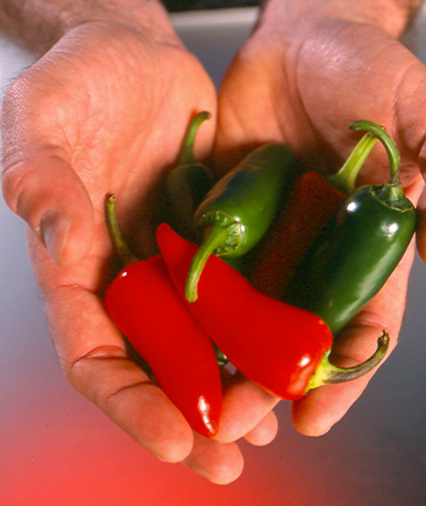Capsicums

Capsicums are any solanaceous (nightshade species) plant of the genus capsicum, as C. frutescens, the common pepper of the garden occurring in many varieties that range from mild to hot, having pungent seeds enclosed in a podded or bell-shaped pericarp. The term "Capsicum" is a genus name encompassing twenty species and some 300 different varieties of plants producing fleshy vegetable pods. Botanically it is part of the family Solanaceae which also gives us tomatoes and tobacco. The three most important species of Capsicums are Capsicum annuum, Capsicum frutescens, and Capsicum fastigiatum. In consumer terms the Capsicum family gives us paprika and chili peppers.
Chili peppers come in many different shapes and sizes, though they all belong to the genus Capsicum. There are small, round and red chiltepins, which grow wild in Mexico and the Southwest and are harvested by millions each year for sale in the U.S. market. Mirasol is a brilliantly red pepper that, instead of hanging from the plant, grows straight up. Habaneros are green when unripe, and ripen to a bold orange or red.
Anatomy and Chemical Characteristics of Capsicum
Capsicum consists of 38% pericarp, 2% inner sheath, 56% seeds, and 4% stalks. The property that separates the Capsicum family from other plant groups and the quintessence of the chili pepper is an alkaloid called Capsaicin (kap-sa-i-sin), an unusually powerful and pungent crystalline substance found in no other plant. Capsaicin is the source of pungency and heat in Capsicums.
Capsaicin is a colorless, crystalline, bitter compound present in capsicum [Previously referred to as capsicine]. It has a molecular weight of 305.46. Capsaicin has a Melting Point of 65ºC, Boiling Point of 81ºC, Vapor Pressure of 40 and a Vapor Density of 1.59 (Air=1). The range in capsaicin content in the pericarp of an average capsicum is about 0.17% to 0.58% and the inner sheath is 6.6% to 7.7%; color is concentrated mostly in the pericarp. Chili seeds contain 19% oil with 0.024% capsaicin content. The percentage of capsaicin in the capsicum plant depends on the species, geographical origin and the climatic conditions.
Capsaicin is produced by glands at the juncture of the placenta and the pod wall. The capsaicin spreads unevenly throughout the inside of the pod and is concentrated mostly in the placental tissue. The seeds are not sources of heat, as commonly believed. From one Kg. of cayenne pepper for example, approximately 2.13 g. of crude capsaicin can be isolated, which is about 20 times the amount found in paprika.